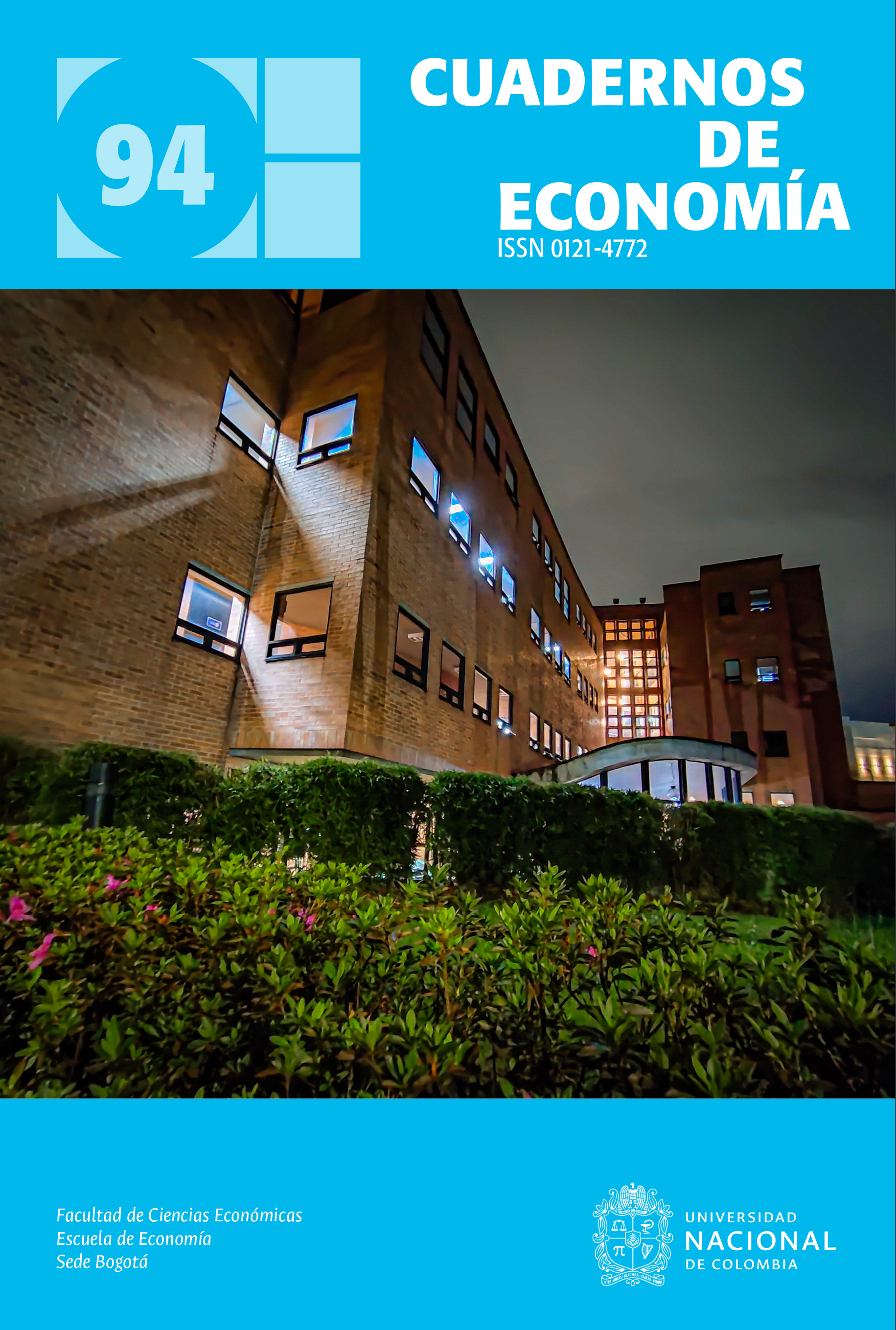Emparejamientos en los mercados laborales de la APE: ¿son igual de eficientes?
Matching in the APE labor markets: Are they equally efficient?
DOI:
https://doi.org/10.15446/cuad.econ.v44n94.107219Palabras clave:
Intermediación laboral, Vacantes laborales, desempleados, eficiencia técnica, colocaciones laborales (es)Labor intermediation, vacancies, unemployed, technological efficiency, job placements (en)
Descargas
La Agencia Pública de Empleo (APE) del SENA, una alternativa para la búsqueda de información laboral en Colombia, opera bajo restricciones: no todos los buscadores de empleo pueden inscribirse y no todos los empleadores acuden a ella. Dado lo anterior, más el carácter regional del SENA, nuestra hipótesis es que la APE induce a diferentes segmentos regionales y ocupacionales del mercado de trabajo, pero que reportan resultados similares en la intermediación laboral, presentando un nivel aceptable de eficiencia en las colocaciones según el análisis de frontera estocástica para los datos de Antioquia, Valle del Cauca y Bogotá D. C.
The SENA Public Employment Agency (APE) is an alternative to search for labor information in Colombia, but it operates under restrictions: it can be used to some job seeker and some employers draw on to her. Indeed, our hypothesis is the APE has induced regional and occupational segments of the labor market, with different dynamics to the national labor market but that report similar results in labor intermediation. The efficiency in the job placements of the APE is acceptable based on the stochastic frontier analysis for the data of Antioquia, Valle del Cauca and Bogotá DC.
Referencias
1. Abdulkadiroğlu, A., Pathak, P.A., & A. Roth. 2005. The New York high school match. American Economic Review 95(2), 364-367. https://economics.mit.edu/files/3024
2. Alt, J., & Iversen, T. (2017). Inequality, labor market segmentation, and preferences for redistribution. American Journal of Political Science, 61(1), 21-36.
3. Arbélaez, L.V. (2019). Análisis del proceso de emparejamiento laboral por área ocupacional en el Valle del Cauca 2014-2018. [Tesis de pregrado, Universidad del Valle]. https://bibliotecadigital.univalle.edu.co/bitstream/handle/10893/14539/3340-0582742-E.pdf?sequence=3
4. Arpaia, A., Kiss, A., & Turrini, A. (2014). Is unemployment structural or cyclical? Main features of job matching in the EU after the crisis (Policy Paper, 91). IZA.
5. Barnichon, R., & Figura, A. (2015). Labor market heterogeneity and the aggregate matching function. American Economic Journal: Macroeco¬nomics, 7(4), 222-249. https://www.jstor.org/stable/24739419.
6. Brücker, H., Hauptmann, A., Jahn, E. J., & Upward, R. (2014). Migra¬tion and imperfect labor markets: Theory and cross-country evidence from Denmark, Germany and the UK. European Economic Review, 66, 205-225.
7. Buhai, I. S., & van der Leij, M. J. (2023). A social network analysis of occupational segregation. Journal of Economic Dynamics and Control, 147, 104593.
8. Castillo, M., Castro, J. A., Raffo, L., & Mora, J. J. (2018). El empareja¬miento en el mercado laboral del Valle del Cauca. Cuadernos de Economía, 37(74), 523-554. https://doi.org/10.15446/cuad.econ.v37n74.60708
9. De Pedraza, P., Guzi, M., & Tijdens, K. (2021). Life satisfaction of employees, labour market tightness and matching efficiency. Interna¬tional Journal of Manpower, 42(3), 341-355.
10. Diamond, P. (1982). Wage determination and efficiency in search equi¬librium. Review of Economic Studies, 49(2), 217-27. https://doi.org/10.2307/2297271
11. Diamond, P. (1984). A search equilibrium approach to the micro founda¬tions of macroeconomics. MIT Press.
12. Diamond, P. (2011). Unemployment, vacancies and wages. American Eco¬nomic Review, 101(4), 1045-1072. https://www.jstor.org/stable/2304589.
13. Fajgelbaum, P. D. (2020). Labour market frictions, firm growth, and inter¬national trade. The Review of Economic Studies, 87(3), 1213-1260.
14. Granovetter, M. (1973). The strength of weak ties. American Journal of Sociology, 78, 1360-1380. https://www.jstor.org/stable/2776392
15. Granovetter, M. (1995). Getting a job: A study of contacts and careers. Chicago University Press.
16. Hausmann, R., & Hidalgo, C. (2011). The network structure of economic output. Journal of Economic Growth, 16, 309-342. https://www.jstor.org/stable/41486815.
17. Hellerstein, J. K., Kutzbach, M. J., & Neumark, D. (2014). Do labor mar¬ket networks have an important spatial dimension?. Journal of Urban Economics, 79, 39-58.
18. Hidalgo, C., & Hausmann, R. (2009). The building blocks of economic complexity. Proc National Academy of Sciences, USA 106 (26), 10570- 10575. https://doi.org/10.1073/pnas.0900943106
19. Hidalgo, C. A. (2021). Economic complexity theory and applications. Nature Reviews/Physics, 3, 92-113. https://www.nature.com/articles/s42254-020-00275-1
20. Jiménez, D. M. (2012). Búsqueda de empleo y duración del desempleo en el área metropolitana de Cali: un recuento para los segundos trimestres de 2009 y 2010. Sociedad y Economía, 22, 163-186. http://www.scielo.org.co/scielo.php?script=sci_abstract&pid=S1657-63572012000100007&lng=pt&nrm=iso&tlng=es
21. Jiménez, D. M., y Salazar, B. (2022). Conexiones y capital social o por qué la información de vacantes no llega a quienes la necesi¬tan. Revista de Economía Institucional. 24, 47, 89-115. https://doi.org/10.18601/01245996.v24n47.04.
22. Jung, P., & Kuhn, M. (2014). Labour market institutions and worker flows: comparing Germany and the US. The Economic Journal, 124(581), 1317-1342.
23. Kleinknecht, A., Kwee, Z., & Budyanto, L. (2015). Rigidities through flexibility: flexible labour and the rise of management bureaucracies. Cambridge Journal of Economics, 40(4), 1137-1147.
24. La Porta, R., & Shleifer, A. (2014). Informality and development. Journal of Economic Perspectives, 28(3), 109–126. https://pubs.aeaweb.org/doi/pdfplus/10.1257/jep.28.3.109
25. Ley 199 de 1994. (1994, 9 de febrero). Congreso de Colombia. Diario oficial 41.216. https://www.funcionpublica.gov.co/eva/gestornormativo/norma.php?i=14930
26. Lora, E. (2019). Forecasting formal employment in cities. Universidad Eafit. https://doi.org/10.12804/revistas.urosario.edu.co/economia/a.10029
27. Lora, E. (2020). La informalidad con otros ojos. [Ponencia para la admis¬ión como Miembro Correspondiente a la Academia Colombiana de Cien¬cias Económicas. Artículo sin publicar].
28. Manning, A., & Petrongolo, B. (2017). How local are labor markets? Evi¬dence from a Spatial Job Search Model. American Economic Review, 107(10), 2877-2907. https://www.jstor.org/stable/44871771
29. Mora, J. J., & Santacruz, J. (2007). Emparejamiento entre desemplea¬dos y vacantes para Cali: un análisis con datos de panel. Revista Estu¬dios Gerenciales, 23(105), 85-91. http://www.scielo.org.co/scielo.php?script=sci_arttext&pid=S0123-59232007000400005
30. Mortensen, D., & Pissarides, C. (1994). Job creation and job destruction in the theory of unemployment. Review of Economic Studies, 61(3), 397- 415. https://doi.org/10.2307/2297896
31. Mortensen, D. (2011). Markets with search friction and the DMP model. The American Economic Review, 101(4), 1073-1091. https://www.jstor.org/stable/23045892
32. Muñoz Tandioy, D., & Acosta Torres, A. (2018). Las nuevas interaccio¬nes de las agencias de empleo a partir de los cambios institucionales realizados por el estado a la política del servicio público de empleo (Dis¬ertación doctoral, Universidad Externado de Colombia). https://bdigital.uexternado.edu.co/handle/001/789
33. O’Clery, N., & Lora, E. (2016). City size, distance and formal employ¬ment creation (CAF – Working paper N° 2016/09), CAF. http://scioteca.caf.com/handle/123456789/959
34. Petrongolo, B., & Pissarides, C. (2001). Looking into the black box: A survey of the matching function. Journal of Economic Literature 39, 390- 431. https://www.jstor.org/stable/2698244
35. Phelps, E., Archibald, G., & Alchian, A. (1970). Microeconomic founda¬tions of employment and inflation theory. W. W. Norton & Company, Inc.
36. Piore, M. J. (2018). The dual labor market: theory and implications. En Social stratification (pp. 629-640). Routledge.
37. Pissarides, C. A. (2000). Equilibrium unemployment theory. MIT Press.
38. Riveros, L. 2016. Análisis sectorial de la función de emparejamiento en Colombia: Eficiencia del Servicio Público de Empleo. [Trabajo de inves¬tigación para optar por el título de magíster en ciencias económicas. Uni¬versidad Nacional de Colombia].
39. Roth, A. (1984). The evolution of the labor market for medical interns and residents: a case study in game theory. Journal of Political Economy, 92(6), 991-1016. https://www.journals.uchicago.edu/doi/abs/10.1086/261272
40. Roth, A., & Sotomayor, M. (1992). Two-Sided Matching. En Handbook of game theory with economic applications 1 (pp. 485-541).
41. Roth, A. (2010). What have we learned from market design?. Economic Journal, Royal Economic Society, 118(527), 285-310. https://www.nber.org/papers/w13530
42. SENA. (2022). Observatorio Laboral y Ocupacional del SENA. https://observatorio.sena.edu.co
43. Stigler, G. J. (1962). Information in the labor market. Journal of Political Economy, 70(5), 94-105. https://www.jstor.org/stable/1829106
Cómo citar
APA
ACM
ACS
ABNT
Chicago
Harvard
IEEE
MLA
Turabian
Vancouver
Descargar cita
Licencia
Derechos de autor 2025 Cuadernos de Economía

Esta obra está bajo una licencia internacional Creative Commons Atribución-NoComercial-SinDerivadas 4.0.
Cuadernos de Economía a través de la División de Bibliotecas de la Universidad Nacional de Colombia promueve y garantiza el acceso abierto de todos sus contenidos. Los artículos publicados por la revista se encuentran disponibles globalmente con acceso abierto y licenciados bajo los términos de Creative Commons Atribución-No_Comercial-Sin_Derivadas 4.0 Internacional (CC BY-NC-ND 4.0), lo que implica lo siguiente:





















